The Elusive Year
by Fred K. Fox
On Tuesday, July 2, l963, the slow moving Studebaker Avanti assembly line in South Bend, Indiana ground to a halt. It would be 34 days before the line would again start to move. At the head oh the halted line was R-4835, a Turquoise R1 with round headlight bezels, a black interior and automatic transmission. Almost completed, R-4835 sat collecting dust until Monday, August 5, 1963. Since the Avanti serial number plates were attached to the frames before the end of the line, the cars in the line were not always in sequential serial number order. This discrepancy allowed R-4836 and R-4837 to slip off the line on July 2nd, while R-4835 remained unfinished.
Nominally, a halt in automobile production in mid summer indicated that a company was taking time off so it could make the necessary changes to put next year’s model into production. For the Avanti, this was only partially true. To better understand the Avanti’s situation, let’s take a brief look at the car’s history.
The Studebaker Avanti, which was introduced in April 1962 as a 1963 model, was brought out mainly through the efforts of Studebaker-Packard president, Sherwood Egbert ---as a high performance grand touring car that Studebaker hoped would breath new life into the company’s deteriorating automobile division. Except for I 959, the automobile division had not made a profit since 1952. There was strong initial demand for the Avanti, but production delays - mainly because of the rush to put the car into production and Studebaker’s inexperience with fiberglass -made it impossible to promptly fill most of the early orders. Publicity about these problems hurt the Avanti’s reputation, and by the time the production problems had been ironed out, most of the early customer enthusiasm had faded away.
In an effort to attract new interest to the Avanti, Studebaker instigated several promotional schemes. Most famous were the various Bonneville speed runs. Another was the adoption of running changes. At first these running changes were mandatory, since several design alterations were needed to overcome the early production problems. Later, it was decided that running changes were the best way to continually improve the Avanti. Egbert got so carried away with the running change concept that he and his sales people decided to discontinue identifying the Avanti by model year. Printed material announced that “The Avanti is not designated by model year, but incorporates changes whenever appropriate.” The decision to abandon model year designations was more than a sales gimmick. Early Avanti's had a serial number prefix of “63R,” but in March 1963 the company phased out the “63” and just kept the “R” with no year identification. The only things left that gave an indication of the year were the various paint codes. These codes continued to use “63” for the first two numbers (in August 1963, “64” paint codes were phased in). Of course, states continued to register Avanti's according to model year. This was based on when the car was sold, not when it was produced. For instance, Studebaker announced that “All new and unused Avanti models, when first sold at retail and licensed or titled after the October 1 (later changed to September 1), 1963.
Page 1
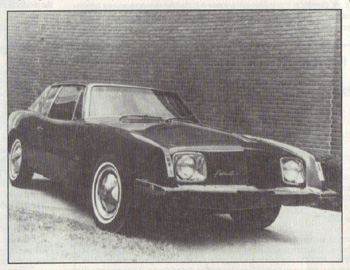
This well known factory photo probably shows the R-4130 prototype car. It was later converted to R3 power and fitted with Halibrand “ma g” wheels. Supercharged R2 and R3 models had identification badges on the sides of the front fenders, while other models did not.
date, will carry the registration year designation of 1964.” In the extreme, this meant that the very first Avanti built, if unsold, could have been registered as a 1964 model. For this reason, the registration year of an Avanti has little relation to when the car was built. The concept of basing the registration year on when a vehicle was sold, instead of when it was built, was used very effectively by Studebaker for the 2R series truck models of 1949-53.Dealers loved this method. It allowed them to update a slow moving vehicle and sell it as a current year model, even if it had been sitting on the lot for over a year. Today, the dating of window stickers and other legislation has helped protect the consumer from the updating practice.
Some of the first Avanti running changes came in the form of new options. Fairly early in the 1963 model year Avanti Gray was brought in as a new color. In May 1963, an all black interior with wood grain accent panels, a wood grain Tenite steering wheel and keystone “S” door panel ornaments were introduced as trim option 813 BKV. This option, which was announced in Sales Letter No. 158 (dated 5/6/63), has caused considerable confusion since many people who own early models with 813 BKV interiors think their Avant i's are 1964 models. This confusion exists since most true 1964 Avanti's have solid color interiors. In contrast, all 1963 Avanti's, except for the ones with the 813 BKV option, have two-tone interiors that feature the main color (Elk, Black, Red, Orange or Turquoise) with a Fawn accent color. For the record, the first production cars with the 813 BKV option were R-4236 and R-4237. Their final assembly date was May 1, 1963. Explanations will be given later, but it should be noted now that any Avanti between R-4236 and R-4834 that has the 813 BKV all black interior is a 1963 model.
Other running changes made during the 1963 model year included the adoption of a radiator air intake grille and roof drip moldings. These two improvements were also offered in kit form for dealer installation on earlier models.
In April 1963, the engineering department instructed the production department to assemble an Avanti with no interior trim, no headlights and no parking lights. This odd car, serial number R-4130, came off the assembly line on April 18, 1963. It was shipped to engineering where the engineering and styling departments used it as a guinea pig for a whole series of proposed running changes. It was fitted with a pre-production 813 BKV interior, thick front seat backs, round console knobs, new grooved rubber sill plates, louvered interior air vent openings, tilt steering wheel, grille, drip moldings, square headlight enclosures (usually called “square headlights”), revised parking lights with single clear lenses and amber bulbs, revised battery location that allowed the use of a standard sized battery, plus many other minor items. This car, which still survives, was used for 1964 publicity shots, converted to R3 power by the Granatellis and used by Egbert. Robert Doehler handled most of the styling changes made on R-4130.
The 813 BKV interior option, drip moldings and grille were, as indicated, quickly put into production, but the other items were shelved until the July shutdown.
The Avanti assembly line stoppage between July 2, 1963 and August 5, 1963 allowed dealers time to sell some of the stockpile of excess Avanti's. It also gave the production department a chance to phase in more of the changes that had been tried Out on R-4130. When most automobile companies make significant styling changes, they instigate the changes on a certain car and then continue them on every car made after that. Not so with the Avanti. Since Studebaker was using the “running change” method of development, the production department, even with the line shut down for over a month, felt no need to instigate all the new changes on any particular car. Sitting at the head of the halted line was our friend R-4 835. Since this Avanti was almost completed, it was not a candidate for revisions. Further down the line was R-4878. This car still lacked its console controls, so it became the first car to be fitted with round control knobs (R-4875 also received the new knobs, but it was evidently further down the line). Next was R-4879. This car lacked its interior hardware and exterior emblems, so it received the new interior door handles, new door lock levers, new sill plates, new quarter window latches, new hinged trunk hatch lid, new silver “S” hood ornament and new “Supercharged Avanti” fender emblems.
Page 2
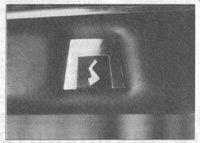
Studebaker Designer Bob Doehler called this interior keystone door panel emblem “Pirate’s Buckle.” First introduced on the 813 BKV option, it was later made standard on all models.
Feature Article News
The following is a list of the upcoming bimonthly feature articles. Photo submissions should avoid showing non-authentic items.
8X10 color 5X7 b&w
Subject TW date deadline deadline
1956 TRUCKS DECEMBER 1987 -PAST- -PAST-
1927 COMMANDERS FEBRUARY 1988 10-20-87 11-30-87
1959 SILVER HAWKS APRIL 1988 12-20-87 1-30-88
1918 STUDEBAKERS JUNE 1988 2-20-88 3-30-88
1965 STUDEBAXERS AUGUST 1988 4-20-88 5-30-88
J. M. STUDEBAKER OCTOBER 1988
SCOTSMAN PICKUPS DECEMBER 19888 8-20-88 9-30-88
We welcome clear and sharp photos of authentic cars or trucks that you currently own or once owned that match any of the upcoming feature articles. The company making our color separations will now accept color transparencies for our covers, but 8”Xl0” (or 8”X12’) color prints are still preferred since they give us a better idea
of what the final product will look like. Technical articles or short interesting stones (typed pages are appreciated!) are also welcome. Please read over carefully the Feature Article News” in the April 1985 Turning Wheels (pages 3 and 13-14) before making a photo submission. If you do not have the April issue, write Fred K. Fox for instructions. Send all contributions to Fred K. Fox 13150 El Capitan Way, Delhi, CA 95315.
Running Changes
As mentioned in the main article, numerous changes were made during the transition from 1963 to 1964 Avanti's. Many of the serial numbers at which these changes were made are given in the December 1963 Avanti Parts Catalog. Possibly not all the numbers are exactly correct. If any reader owns or knows of any Avanti that disproves any of the following numbers, I would appreciate hearing from him or her. It should be rioted that when the Parts Catalog says “after serial number _______,“ the change started with the number listed, not one after It. We know that many items, such as square headlights” (see box), wore only intermittently produced.. during the first I ow days after they were introduced. because of this, cars with higher serial numbers than the ones listed may have been fitted with the older items. Late 1963 and early 1964 models with the 813 BKV option had many of the wood grain items. The serial numbers of many of those 813 BKV cars were less than the starling “wood grain” serial numbers listed here. This is because the numbers listed are for standard equipment items, not optional items. This list, since it concerns 1964 models, does not include the running changes made during the early part of the 1963 model year.
Change Starting with Serial Number
Red & black carpet switched to all black R-4275
Turquoise & black carpet switched to all black R-4314
Orange & black carpet switched to all black R-4399
Drip moldings adopted (1) R-4420
Fawn & black carpet switched to all black R-4709
Wood grained instrument panel adopted R-4730
Wood grained automatic transmission shift plate adopted R-4730
Wood grained non-automatic transmission shift plate adopted R-4849
New console package compartment lid adopted R-4849
Wood grained air conditioning backing plate adopted R-4877
Round console knobs adopted (2) R-4878
New straight inside door handles adopted R-4879
More rounded inside door lock handles adopted R-4879
Rear quarter window latch backing plate adopted R-4879
Door sill plate design changed from round circles to straight lines R-4879
R2 fender emblem changed from “Supercharged” to
“Supercharged Avanti’ R-4879
Hood emblem “5” changed from gold to silver R-4879
Hinged trunk hatch lid adopted R-4879
Square headlight enclosures adopted R-4892
New parking light lenses with clear lens and amber bulb adopted R-4892
Hood support moved from left to right R-4892
Hood insulation increased in size R-4892
Long battery replaced by standard size battery R-4892
Vent intake added to raised part of cowl R-4892
Kick panel vent intake covers changed from mesh to
chrome plastic louvers wire R-4892
Extra rear window molding hold-down clips adopted R-4892
Manifold pressure gage face colors reduced R-5183
Thick cushions on the backs of the front seats adopted R-5361
(1) Drip molding and grille kits were made available for dealer installation on earlier models, so their existence on early cars is not something out of the ordinary.
(2) We know that R-4875 also has round knobs.
Page 4
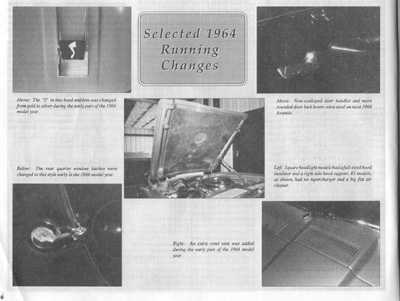
The other proposed changes, such as the square head light enclosures, and the new battery space, would have to be adopted on fiberglass bodies that were not yet completed. The first body to receive these changes ended up mounted on the chassis with serial number R4892. (There is a slim possibility that R-4876 was also produced with some of the body changes.) R-4892 got the new square headlights, revised parking lights, altered battery space, right hood support, larger hood insulator, extra cowl vent, louvered interior vents and improved for the second time rear window hold down clips.
Since Studebaker never made an effort to keep its bodies in sequential order when they were mounted on the chassis, an interesting thing happened when production resumed in August 1963. First, R-4835 rolled off the line on the 5th. On the 8th, R-4878 and R-4879 with their trim changes came off the line. The next day R-4892, the first square headlight car, was completed. But because of the mixed up bodies, it was not followed by a square headlight car. Between August 9th and August 20th, square and round headlight cars were mixed as they came off the line. After August 20th, no more round headlight Avanti's were produced. (Sec the “Square Headlight Enclosures” box ) more details.) Sales Letter #170 (dated 8/21/63) indicated that “Round Headlights” could be ordered as a no charge option. After considerable research, it is this writer’s opinion that any round headlight orders and there could only have been a few made after August 20, 1963 were filled from the large supply of stockpiled round headlight Avanti's already assembled. Production orders indicate that some round headlight models produced in the summer of 1963 had options added or deleted after they came off the line. These changes were made to make the cars fit dealer orders. With the adoption of the square headlights, Studebaker had a hard time selling the remaining round headlight models they had in stock. This is undoubtedly why they offered the round headlight “Option.” Many of the last round headlight models produced were not shipped from South Bend until late 1963 or early 1964. For instance, R4878, the first car with round console knobs, was not shipped (mm South Bend until January 22, 1964, almost one month after the last Studebaker Avanti was produced. Most of these late round headlight cars were eventually sold at. highly discounted prices.
The only significant change on R-4130 that was still left for adoption was the thick front seat backs. These, in somewhat different form than on R4130, were put into production on R-5361, a car that was completed on September 30, 1963. R-5361 was also the first car painted Avanti Maroon. Before being sold, it was used as a display car in the Administration Building’s lobby. The last Studebaker Avanti, a white R3, was completed on December 26, 1963. This car, which survives in excellent original condition, was serial number R-5643.
Now to the problem. Although Studebaker decided in March 1963 to discontinue model year identification of the Avanti, some type of year identification had to be established. Certainly the haphazard state registration method based on sale date was and is unacceptable. Studebaker dealers, used car dealers, Studebaker record keepers and most of all, Studebaker enthusiasts wanted some way, based on serial numbers, to differentiate a 1963 Avanti from a 1964 Avanti. American automobile tradition, especially in the 1950s and 1960s, demanded that every car have a given model year identification. For the Studebaker Avanti, there are three possible positions that can be taken.
Position 1 This position is based on the contention that the production halt between July 2, 1963 and August 5, 1963 was the breaking point between 1963 and 1964 models. Since most of the “running changes” were adopted after this break and the break was during the traditional model change over period, this choice has a strong following. It was the one chosen by SASCO (Studebaker Automobile Sales Corporation) in 1968 when they prepared their detailed production figure tables. They listed 1964 Avanti production as 809. By subtracting 809 cars from the serial number of the last Avanti built, we come up with our old friend R-4835 being the first 1964 Avanti built. As explained, R-4835 was the first car finished on August 5, 1963, the day production was resumed after the summer break. A slight flaw in this method shows up when it is noted that the SASCO people forgot to delete the two serial numbers after R-4835 (R-4836 and R-4837). These are the two out of sequence cars that slipped off the line on July 2, 1963. This means that actual production after the summer break was 807 cars. The 807 figure is more accurate, but the 809 figure is acceptable since it starts at a definite serial number (R-4835) and continues without interruption. The 809 number has been printed in many publications and is the figure used in the production table and other boxes in this article. Cars R-4836 and R-4837 (the ones finished on July 2, 1963) were not shipped from South Bend until January 1964, so there is nothing wrong in including them in the 1964 figure.
page 5
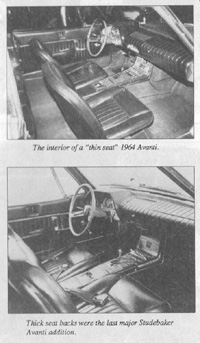
The interior of a “thin seat” 1964 Avanti. thick seat backs were the last major Studebaker Avanti addition.
Thick seat backs were the last major Studebaker Avanti addition.
Page 6

Upper Left: This is the interior view of an interesting 1964 Avanti owned by member David Ridge of Hawesville, Kentucky .It is R-4875. Although it has the 1963 style two tone Deluxe interior, it has wood grain panels and round knobs on the console controls. It was the next to last Avanti built with the non-pleated Deluxe interior. The round console knobs on this car prove that this feature existed at least three cars before the Parts Catalog said they were introduced! The inside door handles and door lock levers are the 1963 style. David has owned this car since new.
Upper Right: An engine shot of David Ridge’s R2 Avanti (R-4875). This early 1964 model has round headlights, thus it has the left hood support and long battery. The radiator cap, as David noted, is different from the original “eared” style.
Page 7
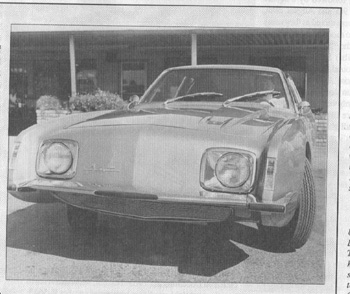
Cover Cars
Our front cover brings back memories of 1964. Sliding into the space between the 9162 Lark Daytona convertible and the 1952 Buick sedan is the Kaiser family’s prize winning “thick seat” 1964 Tourquoise R2 Avanti (r-5392). Also parked at Rich’s Drive-in in Brentwood, California is a 1964 Corvette and a number of Circa 1964 trucks. In the passenger seat of the Avanti is long time SDC member Steve Kaiser of Oakley, California. The Roller skating carhop near the Buick is Steve’s wife Sara. The Daytona also belongs to the Kaiser family. Special thanks to Steve Kaisetr for making the arrangements for this nostalgic photo.
The back cover car is a Gold 1964 R1 Avanti (R-5311) that is part of the Fox family collection in Delhi, California.
Right: Avanti view of the Kaiser family’s 1964 Avanti (R-5392).
Square Headlight Enclosures
The production orders in South Bend do not indicate which cars were fitted with ‘square head lights” and the later style parking light lenses. —Actually, all Studebaker Avanti's had round head-lights, but the later ones with square headlight enclosures are usually called “square headlight” models. Square headlight models also normally came with a right side hood support, normal size battery and a full size hood insulator. The 1963-64 Avanti Parts Catalog indicates that square headlight models started with serial number R-4892. If one counts from [1-4892 to the last Avanti built, one arrives at 752 Avanti's built with square headlights. The problem is that although R-4892 does have square headlights, many Avanti's built after it have round headlights. By contacting several Avanti owners between R-4892 and R-501 0, we have been able to come very close to determining which cars were fitted with square headlights. Body numbers are no help, but two other items do help. From R-4892 to R-4948, all cars that were fitted with square head lights used the 1964 production order item numbers and 1964 paint codes, while the round head light models in that range used 1963 numbers and codes. After U4948, 1964 numbers arid codes were used for all Avanti's. Since we know that some round head light models wore built alter [1—4948, another method of differentiation was needed. The answer was found in the line number” printed on the production orders. The first group of 15 square headlight models (intermittently - between serial numbers 4892 and 4973) were all built for car shows and other special purposes. Except for the Sears Allstate cross-country car (R-4938, line #218), all these square headlight models had line numbers from 3992 to 4005. Round headlight models built during the same period had smaller line numbers. From contacting various Avanti owners, we feel the switch from round to square headlights on regular production models was made between line number 3982 (serial number 4996—a round headlight model) and line number 3990 (serial number 5004 — originally a square headlight model). Hoping that the person in charge liked working by tens, we will guess that the change was made at line number 3990 (serial number 5004). The following list is based on this estimation. If the estimation is correct, then we can say that there where 655 1964 Studebaker Avanti's built with square headlights (this figure does not include the prototype). If anyone has information that conflicts with the list, please contact Fred K. Fox (13150 El Capitan Way, Delhi, CA 95315).
Serial Number Listing of Square Headlight Studebaker Avanti's
Serial Number Notes Line Number Final Assembly Date
R-4130 Prototype 3233 4/18/63
R-4892 Photo Publicity Car (1) 3994 8/9/63
R-4907 Paris Show Car 3992 8/12/63
R-4923 Oregon Show Car 3995 8/13/63
R-4938 Sears Allstate cross-country car 218 8/13/63
R-4940 San Francisco Show Car 3996 8/14/63
R-4942 Los Angeles Show Car 3997 8/14/63
R-4946 Texas Show Car 3998 8/14/63
R-4948 Kansas City Show Car 3999 8/15/63
R-4950 Atlanta Show Car 4000 8/15/63
R-4957 Press Review Car 3993 8/15/63
R-4962 Devon, PA Show Car 4001 8/16/63
R-4965 Allison Park, PA Show Car 4002 8/16/63
R-4968 New Jersey Show Car 4003 8/16/63
R-4970 Chicago Show Car 4004 8/16/63
R-4973 “To Engineering” (2) 4005 8/16/63
R-5004 Regular Production (3) 3990 (4) 8/20/63
R-5005-R5643 All Square Headlights --
(1) R-4892, according to the Parts Catalog, was the first production Avanti to have square headlights. This car which was one of the special publicity cars belongs to Minot Percy of Marblehead, Massachusetts. We have confirmed that it does have square headlights.
(2) R-4973 was the last special square headlight model built. It is now owned by member Dennis Day of Cedar Rapids, Iowa.
(3) If our estimate is correct, this is the first regular (produced for sale directly to a retail customer) production square headlight model built. It was purchased new by member Bea Hartigan of Huntington, New York. Shortly after purchase, the car was damaged in the front. When Bea had it repaired, she chose to have it rebuilt with round headlight panels and trim. Since she is the original owner, we were fortunately able to get correct information about the headlight history of this car.
(4) Starting with serial number R-5006, a whole new range of much smaller (starting with number 173) line numbers were used. The Allstate car, although built earlier, was assigned one of these smaller line numbers.
Note: Sales Letter No. 170 (dated August 21, 1963) indicates that round headlights could still be ordered, but it is estimated that after August 20,1963, any orders for round headlights were filled from the large stockpile of round headlight cars already produced.
Position 2 This position is the “silent” one taken by the production department in August 1963. Although Egbert had them do away with the “63” from the serial numbers, the production department continued to use 1963 Studebaker production order item numbers and, as mentioned, 1963 Avanti paint code numbers. When production resumed on August 5, 1963, they initially let the round headlight models go by with the 1963 production order item numbers and paint codes, but— up to serial number R-4948 — they assigned all square headlight models that came down the line the new 1964 Studebaker production order item numbers (for instance, Twin Traction was “50” in 1963 and “77” in 1964) and 1964 Avanti paint codes. After R-4948, both square and round headlight models were assigned the 1964 item numbers and paint codes. Altogether, 696 Studebaker Avanti's were produced with the 1964 item numbers and paint codes. A major problem with this method is that it does not provide a definite serial number starting point. From serial number R-4892 to R-4948 (August 9, 1963 to August 15,1963) cars were produced with both 1963 and 1964 item numbers and paint codes.
Page 8
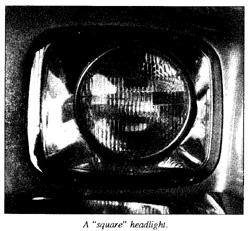
A “square” headlight.
Position 3 This position is the simplest, but the least accepted. It assumes that the only 1964 Avanti's are those that came from the factory with square headlights. These were the same models that could use a standard size battery, had a right side hood support, and used the one-piece clear parking light lenses. A total of about 655 Studebaker Avanti's were built with square headlights (see the “Square Headlight Enclosures” box for more details). A weak point with this position is that quite a number of round headlight models have been converted to square headlights. This happened mainly because round headlight repair panels and trim became unavailable shortly after Studebaker Avanti production ended. It should be noted that only the square headlight Avanti's were assigned the S.A.E. “64” identification on their headlight and parking light assemblies.
Well, how many 1964 Avanti's were built? Were there 809,807,696 or 655? At this time, the 809 figure has the greatest following. If any number less than 809 is accepted, people who own transition cars would have to start calling them 1963 models. This would meet with strong resistance since it has been an assumption of long standing that these cars were 1964 models. Even now, it is difficult to convince some owners of true 1963 Avanti's which were originally sold in the 1964 model year and registered as ‘64s that their Avanti's are really 1963 models.
Other dividing points between 1963 and 1964 Avanti production have been suggested, but evidence is lacking to support their adoption.
Of course, Sherwood Egbert, if he was here to tell his story, would explain that all this discussion is purely academic, for there were neither 1963 models nor 1964 models. There were only Studebaker Avanti's and they were designed to be ageless. *
Much of the serial number information presented in this article was unearthed by George Krem, Jr., our current national president. George has spent many years analyzing Studebaker production orders. He has been an Avanti fan since the day the car was introduced, and over the years he and his father have owned several different Avanti's. They currently own two of the nine R3 Avanti's.
The Parking Light
Lens Mystery
Starting with the 1963 model year, the U. S. government required that all American built cars sold in the United States befitted with amber parking lights/front direction signal lights. Studebaker, in 1963, met this regulation by using amber lenses with clear bulbs. For the 1964 model year, they switched and began using clear lenses and amber bulbs. On Avanti's, this started with the square headlight models.
In April 1964, over three months after the last Studebaker Avanti was produced, the company announced they were switching back to amber lenses and clear bulbs. According to Studebaker Service Letter J-1964-7, dated April 9,1964, the Canadian plant was making the switch back on Lark- type vehicles because some states (New York, New Jersey, Pennsylvania, Virginia, California and the District of Columbia) were occasionally expressing dissatisfaction with the clear lenses.
Besides switching to amber lenses for 1964 Lark- types, Studebaker, In April 1964, also offered amber lenses for domestic 1964 square headlight Avanti's. These lenses, part #1360697, were listed in the December 1963 Avanti Parts Catalog, but except for possible installation on a few export models, there is no evidence that any 1964 square headlight Avanti's sold in the U.S. came from the factory with amber lenses. —This fact has been examined closely by George Krem and myself. We have found no proof that any square headlight Studebaker Avanti sold in the U. S., including the last two built, came from the factory with amber parking light lenses.
Quite a number of 1964 square headlight Avanti's now have amber lenses. This is generally because broken clear lenses were replaced with amber lenses supplied by Studebaker or Avanti Motors (the Avanti II used amber lenses). There is a very slim chance that a few dealers who still had Avanti's in their show- rooms in April 1964 switched them to amber lenses. If this happened, it is possible that somebody could have purchased a new square headlight style 1964 Avanti with amber parking light lenses. Is any reader aware of this happening?
Thanks to members Dave Thibeault and Dick Quinn for providing in formation about Service Letter J-1964-7.
1964 Studebaker Avanti Model RQ Specifications
Model Symbol R
Body Symbol Q
Engines R1 R2 R3 R4
Bore (inches) 3.56 3.56 3.65 3.65
Stroke (inches) 3.62 3.62 3.62 3.62
Displacement (cu.in.) 289 289 304.5 304.5
Horsepower 240 @ 5000 rpm 289 @ 4800 rpm 335* @ 5350 rpm 280 @ 5000 rpm
Compression ratio 10.25:1 9:1 9.75:1 12.1
Carburetors (Carter AFB) 1 1 1 2
Paxton Supercharger no yes yes no
* With optional dual valve springs and a high-output pulley set, R3 power increased to 400 gross brake horsepower at 6000 rpm.
Wheelbase 109 inches Engine Colors
Shipping Weight (R1) 3140 lbs. R1 & R2: Black block, heads, pan, pulleys,
Fuel Tank 21 gallons starter, power brake and steering units with
Tire Size 6.70X15 chrome valve covers, breather caps (with STP
decals) and oil dip stick handle. The fan was
Starting serial number: R-4835 orange and the automatic transmission dip
Ending serial number: R-5643 stick handle was yellow. Stainless steel was
used to ignition shielding, the air cleaner
Studebaker Avanti serial number plates are housing and R2 carb air inlet. Most, if not all,
mounted on tile right frame side rail in front of superchargers were orange from the factory
#1 body hold down bracket. and black when rebuilt by Paxton. Many 1964
Avanti's came from the factory with a black
All Studebaker Avanti's were assembled in case “Studebaker” battery with red caps. A
South Bend, Indiana. “warning” label was by the battery, an air
cleaner decal was on the air cleaner canister
Engine Number Prefixes and most ‘64 Avanti's had a silver and black
R1 R “Studebaker craftsmen” decal on the right valve
R2 RS cover.
R3 R3S
R4 R4 R3 & R4: These engines had a red block,
heads and pan, and a chrome valve lifter cover
Avanti engine numbers were stamped on a boss (valley plate). The R3 carburetor pressure box
at the top side, front end of the cylinder block, was natural metal color. All other parts were
next to the left front corner of the valve lifter the same colors as on R1 & R2 engines.
cover (valley plate).
1964 Avanti Colors
Exterior
Avanti Black (1) P-6430
Avanti White P-6431
Avanti Turquoise P-6432
Avanti Gold P-6433
Avanti Red (2) P-6434
Avanti Gray P-6435
Avanti Maroon (3) P-6436
(1) Avanti Black in 1964 was a “Special Order” color that cost an extra $35.50. Only 32 1964 Avanti's were painted Avanti Black.
(2) Avanti Red, according to sales letter No. 174, was to be discontinued on October 1, 1963, but a few Avanti's that were assembled after that date were painted Avanti Red.
(3) Avanti Maroon was not introduced until September 30,1963.
Note: Early 1964 models with 1963 production order item numbers used 1963 paint codes that included a “63” instead of a “64.”
Interior
Available with these
Color Exterior Colors
Black vinyl, 813 All
Turquoise vinyl, 823 Black, White, Turquoise
Claret vinyl, 833 Black, White, Gold, Gray,
& Maroon
Smoked Elk vinyl, 843 Black, White, Gold, Red
Metallic Red vinyl, 853 Black, White, Red, Gray
Metallic Red vinyl was supposed to be discontinued on October 1,1963, but a few Avanti's assembled after that date were filled with Metallic Red vinyl.
Claret vinyl was introduced in late August 1963.
Most 1964 Avanti's had pleated Regal vinyl, mono-color interiors, black carpets, and wood grained consoles and instrument panels. As in 1963, the headliner was white, although the headliner material was different from that used on early Avanti's. The roll bar cover, on most 64 models, matched the color of the seat upholstery. Some early 1964 models that did not have the 813 BKV option were fitted with 7 Deluxe and 9 __ Regal 1963 interiors.
Page 9
1964 Avanti Options and Accessories
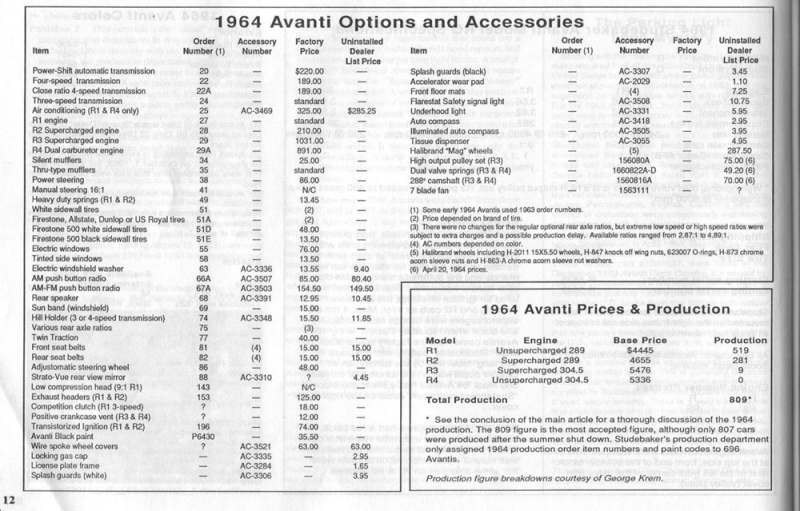
1964 Avanti Prices & Production
Model Engine Base Price Production
R1 Unsupercharged 289 $4445 519
R2 Supercharged 289 4655 281
R3 Supercharged 304.5 5476 9
R4 Unsupercharged 304.5 5336 0
Total Production 809 *
* See the conclusion of the main article for a thorough discussion of the 1964
production. The 809 figure is the most accepted figure, although only 807 cars
were produced after the summer shut down. Studebaker’s production department
only assigned 1964 production order item numbers and paint codes to 696 Avanti's.
Production figure breakdowns courtesy of George Krem.
R3 & R4 Models
One of the great mystiques that surround the Studebaker Avanti story is the super high performance R3 and R4 models developed by the Granatelli brothers. The supercharged R3 model was supposed to be released very early in Avanti production, but none were actually produced until the 1964 model year. Although many after market R3 Avanti's exist, only nine were assembled by the factory. There were no dual carb R4 Avanti's produced by the factory. The factory also produced one 1964 R3 Commander and one 1964 R4 Daytona. R3 Avanti's were capable, with the right final drive ratio, of exceeding 170 mph. To this day, they are still the fastest true production cars ever marketed by an American automobile manufacturer. Those who would like a detailed report on R3 Avanti's should hunt up the December 1986 issue of Special Interest Autos.
For identification, it should be remembered that R3 Avanti engines had their carburetor enclosed in a pressure box, while R2 engines had an exposed sealed carburetor that had its air ducted into the top. Both R2 and R3 models were super - charged, while R1 and R4 models were UN-supper - charged.
Here is a list of the nine production R3 Avanti's. Serial
Number Color Transmission
R-5089 Turquoise 4-speed
R-5237 Black 4-speed
R-5394 White 4-speed
R-5532 Turquoise 4-speed
R-5546 Gold 4-speed
R-5593 Gray Automatic
R-5625 Black Automatic
R-5642 White Automatic
R-5643 White Automatic
Page 10
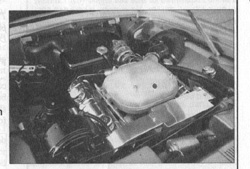
The engine compartment of R-5546. This car is owned by George Krem Jr., president of SDC. George and his father also own R-5642. Only nine production Avanti's were produced with R3 engines.
1964 Avanti Literature
Sales Literature
1. Full line Studebaker color catalog PD 64-10, 81/4” (161/2”) X 11 1/2”, 20 pages (Canadian version was also PD 64-10, but it had thinner paper.)
2. Full line Studebaker color catalog PD.-64-11, 6 1/2’ X 4”, 12 pages
3. Full line Studebaker color and black and white catalog PD 64-55, 6 1/2’ X 4”, 16 pages (This is like PD.-64-11, but with an extra cover sheet that features the Avanti and Sears Allstate tires.)
Miscellaneous
1. Avanti Color and Upholstery Selector plus Features and Facts. This gold 1963 binder was updated with 1964 inserts.
2. Avanti Owner’s Guide. No year is given. The 1964 version is white with blue and red print on the cover. *
3. Avanti Accessories. No year is given. The 1964 version is white with blue and red print on the cover. *
4. Radio instruction folder.
5. Avanti Chassis and Body Parts Catalog. Dated December 1963.
6. Avanti Workshop Manual. The 1963 manual was used for 1964.
7. Various Sales and Service Letters.
8. 1964 Avanti Order Guide, PD-64-02.
9. Avanti Factory Advertised Delivered Prices, PD 64-67
10. The big 1964 Different.., by Design show - room book only has one page (6/1) on the Avanti.
* Unlike the 1963 Owner’s Guide and Accessories brochures, these items had no year printed on them. They were the product of Egbert’s “no model year” promotion. As mentioned in the main article, the factory ended up in August 1963 with a large stockpile of unsold 1963 Avanti's. Rather than supply them with the dated 1963 Owner’s Guide and Accessories brochures, they shipped them with the undated 1964 items listed here. Because of this, the 1964 Owner’s Guide and Accessories brochures included photos of both 1963 and 1964 models. Interestingly, 1964 Avanti Owner’s Guides were also provided—with some addendum information — to owners of early Avanti Is. Egbert had no idea that his “no model year” approach would help save Nate Altman a few printing bucks.
Further Reading
Studebaker — The Complete Story, pages 3 17-325.
Studebaker: The Postwar Year, pages 132-143.
The Studebaker Century, pages 164-167, 176 -179 and 181.
Avanti (Avanti literature reprints), pages 10-13 and 68-81.
Industrial Design (Raymond Loewy’s book), pages 86 and 180-1 96.
Special Interest Autos, Jan-Feb 1976 (#32), pages • 12-21 and 60 - 61.
Special Interest Autos, December 1986 (#96), pages 30-37. (R3 report and driving impression)
Avanti Newsletter (AOAI publication), Summer 1983 (#52), pages 7-9 (report on the 1964 prototype, R 4130).
Avanti Newsletter#1 3 (Good photos of many of the running changes)
Turning Wheels, February 1981 (Vol. 13, No. 2), pages 6-13 (1964 Studebaker introductions)
Motor Trend, October 1963, pages 30+31 (1964 Studebaker introduction—same article reprinted in February 1987 TW
Motor Trend, November :1963, pages 94-97 (1964 Studebaker introduction—same article reprinted in February 1981 TW)
Hot Rod, November1963, page .104 (report on the Sears Allstate cross-country Avanti)
Dozens of other articles have been written about the Studebaker Avanti, but most only cover the 1963 models. The ones that are specifically on ‘64s normally only cover the R3 models.
Recaps
The purpose of this section is to review any new material that has been discovered which affects the information presented in earlier Feature Articles. Contributions to this section should be sent to Fred K. Fox, 13150 El Capitan Way, Delhi, CA 95315.
February 1987 Feature Article: 1960-64 Champ
Member David R. Harriman of Venice, Florida has provided a lot of new information on prewar Studebaker commercial vehicle sliding rear windows. Although Ford trucks and Canadian Mercury trucks had sliding rear windows before the Studebaker Champ, David has provided information that proves that Studebaker had commercial vehicle sliding rear windows before the 1940-47 Fords mentioned in the August issue of this column. David provided the following information:
1935 Studebaker Truck Parts Manual
For DeLuxe cab: Plate glass sliding rear window #64570
Safety glass sliding rear window #645727
1939 Parts Book
Special Equipment for J5, KS & L5 Coupe-Express:
sliding rear window #647470
sliding rear window with screen #647370
1939 Truck Salesman’s Book (dated Dec. 15, 1938)
Optional rear sliding windows:
Safety glass #525 $4.61
Safety glass with screen #526 $8.42
Most interesting! Have any of these prewar Studebaker sliding rear windows survived? Member Don Ellwyn of Port Coquitlam, British Columbia also wrote in explaining the fact that sliding rear windows were an option for 1937-39 Coupe-Express models.
In the last column, we mentioned that member Richard Hunt reported owning 1928 Chevrolet Model LO truck with a sliding rear window. Richard purchased the truck from the original owner in 1938 and knows that the sliding window has been in it since new. The ‘28’s screen side body was built for Chevrolet by Hercules (evidently a body company and not the engine manufacturer). Dick’s sliding window is in an oak frame with a felt weatherstrip and slides between two flanges. A piece of spring steel is used to hold it in place and keep it from rattling. Although the definitions are a little vague, Dick is fairly certain that the parts for this early sliding window are listed in a 1929 Chevrolet parts book. Well, we now have the Champ’s sliding rear window predated by 32 years. Can we take it back farther?
April 1987 Feature Article: 1962 GT Hawks
Proof of a set of factory installed narrow whitewall tires on a 1962 Studebaker has been discovered! While looking over some 1962 production orders, George Krem came upon a 1962 Lark V8 Daytona hardtop (serial #62V42444) that was fitted at the factory with special order “narrow band” 6.70X15 Firestone 500 whitewall tires. These are the same tires that were optional on the Avanti. The car’s final assembly date was June 8, 1962. George only spotted the one car, although possibly others were shipped with the same kind of tires. He found no Hawks with the option.
Random Notes
Special kudos to Larry Swanson, our esteemed editor. Last month’s issue marked Larry’s 15th year as editor of Turning Wheels. Few people have the fortitude and dedication it takes to stick with a club publication for 15 years.
Larry’s first issue came out in September 1972. Counting covers, it only had 20 pages. The most interesting feature in the issue was a group of pictures by Steve Jones of some of the styling study hulks in the Studebaker “graveyard.” Among the cars for sale in September 1972 were a nice 1953 commander Starliner for $1600 and an “immaculate” 1963 R2 Avanti for $3200.
Our Club’s first publication, The Presidential News- letter, was edited by Harry Barnes. Volume 1, Number 1 of The Presidential Newsletter was published during the summer of 1963. Other national SDC editors before Larry were Karl Haas, (Gary Cameron and Ed Flaherty.
Frost and French, a former Southern California Studebaker dealership and a long time west coast SASCO / Avanti Parts / Studebaker Parts associated parts out let has been purchased by Studebaker's West, a well known Redwood City, California Studebaker parts and repair service shop. Frost and French’s complete inventory is being moved north to Redwood City. Studebaker's West is owned by Herman and Carl Thorns, two long time SDC members. Studebaker's West’s address is 335A Convention Way, Redwood City, California 94063 - (415) 366-8787.
Frost and French was in the Studebaker business for 63 years. For many years, the company was run by Bob Moss and Walter Bibens. Many thanks to the former owners for their dedicated service to SDC members, and good luck to Studebaker's West in their expanded business.
Member Roy Nagel has sent us information about a very special SAE (Society of Automotive Engineers) session coming up on October 21, 1987 at the Hyatt Regency Hotel in Dearborn, Michigan. Designers of some of the most significant cars of the past half century have been invited to speak at the session. Among those who will be taking part are Zora Arkus - Duntov, father of the Corvette; Alex Tremulis, Tucker designer; Eugene T. Gregorie, stylist on the original Lincoln Continental project; Gordon M. Buehrig, creator of the 1936-37 “coffin nose” Cord design; and most important to us, Robert Bourke, Loewy’s chief designer on the 1953 Studebaker Starliner and Starlight project. Probably never again will such an esteemed list of automotive designers gather together at one time. Today’s “used soap bar” school of design leaves little room for the creative genius that produced the distinctive automobiles of yesteryear.
The session planners hope to have cars on hand that represent the best efforts of each designer. For more information, call Cathy Joyce at (412) 776-4841.
R. Perry Zavitz, in a July issue of Old Cars Weekly, corrected most of the errors made in his April 16, 1987 article.
Oldsmobile is making a lot of hoopla this year about being 90 years old. Studebaker passed that milestone in 1942. Because of the war, no fuss was made about it. A booklet was printed in 1940 that recognized Studebaker’s 88th year. Studebaker anniversaries were also celebrated in 1902, 1927 and 1952.
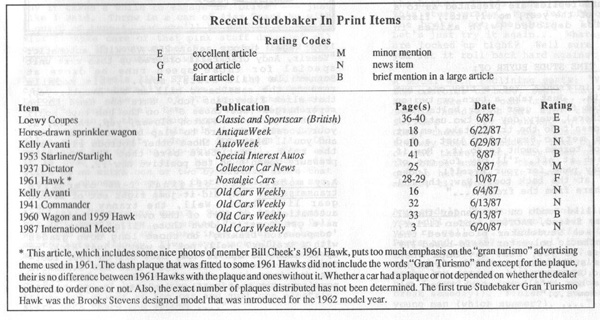
Page 11
* This article, which includes some nice photos of member Bill Cheek’s 1961 Hawk, puts too much emphasis on the “gran turismo” advertising theme used in 1961. The dash plaque that was fitted to some 1961 Hawks did not include the words “Gran Turismo” and except for the plaque, their is fl() difference between 1961 Hawks with the plaque and ones without it. Whether a car had a plaque or not depended on whether the dealer bothered to order one or not. Also, the exact number of plaques distributed has not been determined. The first true Studebaker Gran Turismo Hawk was the Brooks Stevens designed model that was introduced for the 1962 model year.